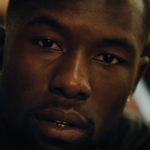
It may be inevitable that the 89th Academy Awards will always be remembered as the night that PriceWaterhouseCoopers stole the show (certainly an achievement of its kind in the world of accounting). But the awarding of the Best Picture Oscar to Barry Jenkins’s Moonlight, the first Best Picture Oscar to go to a movie directed by a black director represents a landmark in the long and vexed history of the movie business honoring itself. A meditative, slow cinema study of a young gay African American boy named Chiron growing up in Miami’s Liberty City neighborhood; what movie could seem more improbable in the age of superheroes and Pixar.
As played by three different actors (Alex Hibbert; Ashton Sanders; Trevante Rhodes) at different periods of his life, Chiron also carries three names in the script—Little, Chiron, and Black—and in many ways his character remains a cipher. While the other people in his life offer threats, encouragement, pleas for money, invitations to friendship—Little/Chiron/Black remains a character of few words, his interior life a mystery the movie invites us to explore and imagine.
All of these characteristics, along with its modest box office performance, not only make Moonlight an unlikely choice for Best Picture, but an anomaly in the history of Hollywood. There are exactly zero white-identified characters in the movie, and the story makes no easy concessions in terms of having a valuable lesson or message to impart, unless it’s the radical point—maybe the most radical point in American history—that black lives matter.
 But the epic envelope fail engineered by PWC also highlighted what had begun emerging as a kind of feud story in the entertainment press, that the pre-Oscar’s favorite La La Land, Damien Chazelle’s contemporary musical about a young woman struggling to make a career as an actor in the movie business who falls in love with an equally struggling and somewhat deluded jazz musician, was somehow the artistic opposite of Moonlight, a symbol of tired old practices in Hollywood that represented everything Moonlight wasn’t. Obviously, some of this reaction was the inevitable backlash against any movie that emerges as a “sure thing,” although it’s helpful to remember that emergence was in itself surprising, given La La Land’s own modest beginnings. And I’m not going to be mounting an argument about whether both La La Land and Moonlight are “good” movies. I mean, I think they both are, but if you like one and not the other, or even if you hate one and love the other, well, that’s how art works.
But the epic envelope fail engineered by PWC also highlighted what had begun emerging as a kind of feud story in the entertainment press, that the pre-Oscar’s favorite La La Land, Damien Chazelle’s contemporary musical about a young woman struggling to make a career as an actor in the movie business who falls in love with an equally struggling and somewhat deluded jazz musician, was somehow the artistic opposite of Moonlight, a symbol of tired old practices in Hollywood that represented everything Moonlight wasn’t. Obviously, some of this reaction was the inevitable backlash against any movie that emerges as a “sure thing,” although it’s helpful to remember that emergence was in itself surprising, given La La Land’s own modest beginnings. And I’m not going to be mounting an argument about whether both La La Land and Moonlight are “good” movies. I mean, I think they both are, but if you like one and not the other, or even if you hate one and love the other, well, that’s how art works.
What I do want to argue for is that love them or hate them, think either or both is overrated or underrated (and the whole Oscars ritual feeds all of these reactions), what is also remarkable about what happened last Sunday night (really Monday morning, for those of us in the eastern time zone) is that two avant-grade, experimental movies were neck-and-neck choices for mainstream Hollywood’s biggest award.
Most of the critical dialogue around both movies centers, as it usually does, around topics like the “subject matter” of the films—the life of a poor African American boy struggling with the twin burdens of racism and homophobia; a nuanced, complex, and sympathetic portrayal of a community often stereotyped in the movies and the speeches of the current President as brutal and dangerous; a story of ambitious young dreamers trying to make their way in the world; a bittersweet look at love, desire, and ambition—I would suggest that our experiences of and reactions to these movies are equally shaped by their formal challenges to conventional Hollywood movie storytelling, challenges that also ask us to rethink how we understand any cinematic experience.
Interviews with the director Barry Jenkins have rightly focused on his and his co-writer and playwright Tarrell Alvin McRaney’s identification with the character of Chiron and the Liberty City neighborhood where all three grew up. As Jenkins’s says in the speech he was going to give before Warren Beatty was handed the wrong envelope, “We are Chiron. . . . And you don’t think that kid grows up to be nominated for eight Academy Awards. . . . But now it’s happened.” There is no question that Moonlight represents a milestone. But Jenkins is also part of a generation of young cinephile directors, an admirer of the great Hong Kong stylist Wong Kar Wai, and Moonlight is a formally arresting movie, revealing the influence of Wong in its carefully composed set pieces and vivid and at times anti-naturalistic color schemes, especially the use of various shades of blue, a reference to the original title of McRaney’s play In Moonlight Black Boys Look Blue. That title, and Jenkins’s manipulation of the color palette in Moonlight, works as a formal challenge to our visualized and naturalized understanding of race by challenging our habitual experience of visual understanding in the movies.
[youtube https://www.youtube.com/watch?v=LwmEWNXIsNk&w=560&h=315]
This experimentation challenges our understanding of identity in Moonlight in ways that pay homage to silent cinema. As I said above, Little/Chiron/Black says very little in the movie. Instead, we are encouraged to study his faces (more on this in a moment) in a series of close-ups, just as silent cinema made the contemplation and even fetishizing of faces the central strategy in provoking and inciting emotional responses in viewers, responses these viewers then impute to the characters.
 And the plural “characters” is deliberate, as Chiron is at once one and three people, the actors who play “the same” person at different life stages chosen not for any particular similarity of physiognomy but for the individual intensity of their silent expressions. We struggle to get to know this character/these characters as a result of this formal avant-gardism, but that is the whole point for a person struggling for self-knowledge in a world that constantly places him in categories of race, gender, class, and sexuality. Even the poster image for the movie underlines this radical instability of identity as well as the importance of formal composition and color scheme. And as movie viewers we participate in that process, wanting ourselves to “place” characters as soon as they appear according to our own pre-existing social categories and our experience with conventional Hollywood ways of typing and stereotyping.
And the plural “characters” is deliberate, as Chiron is at once one and three people, the actors who play “the same” person at different life stages chosen not for any particular similarity of physiognomy but for the individual intensity of their silent expressions. We struggle to get to know this character/these characters as a result of this formal avant-gardism, but that is the whole point for a person struggling for self-knowledge in a world that constantly places him in categories of race, gender, class, and sexuality. Even the poster image for the movie underlines this radical instability of identity as well as the importance of formal composition and color scheme. And as movie viewers we participate in that process, wanting ourselves to “place” characters as soon as they appear according to our own pre-existing social categories and our experience with conventional Hollywood ways of typing and stereotyping.

And this is where the contrast with La La Land usually comes in. Insipid, fluffy, and lightweight, this from the movie’s detractors, but even many of the movie’s champions hail it as “escapist” and light-hearted. Unlike the way Moonlight seems to confront us with social conflict and trauma, La La Land takes us to a fantasy world, just like we’ve always relied on Hollywood to do. But it is a fantasy world of LA traffic jams, tiny apartments shared with three roommates, endless minimum wage jobs and constant frustration and rejection. And a love story that doesn’t work out in the end; in fact, the movie shows us the ending we may have wanted, only to take it away again in the end.
But this argument itself is again getting into the debate over whether the movie is “good” or not, and the point I really want to make is one made by the movie’s director, Damien in talking about how as a film student he moved from hating musicals to loving them:
“Suddenly, these movies that seemed very much like the epitome of Hollywood confection, of Hollywood fluff, suddenly seemed to me like these strange, audacious, experimental movies,” he says. “I became fascinated by an era in Hollywood where the studios opened up their coffers and let filmmakers make weird, avant-garde movies in mainstream packaging.”
Potentially self-serving? Sure, maybe, but that doesn’t make him wrong. Musicals, romantic comedies, horror—all are genres of classic Hollywood that share a willingness to challenge, remake, and even abandon formal attributes of conventional Hollywood movie making. Characters move from talking into singing and dancing and back again. Lovers take to the skies—of the Griffith Park planetarium—and the city of Los Angeles itself oscillates between strip mall grunge and movie set atmosphere, an atmosphere that also includes “real” movie sets. Many have criticized the movie for being another example of how much Hollywood loves movies about, well, Hollywood, but there’s no reason that “Hollywood” is any less legitimate a topic than any other. In fact, the best “Hollywood” movies—like that other avant grade film Singin’ in the Rain—raise questions of the movies as movies, as experiences of desire and regulators of social perception, as expressions of human imagination and as corporate products.
And musicals are now always “controversial,” not just for subject matter but for just being musicals. Think of the intensely divided reactions sixteen years ago to Baz Luhrmann’s avant garde Moulin Rouge!, a backstage musical that mixed historical periods and combined pop and opera, just as Moonlight’s sonic background combines chamber music and hip hop. Likewise, the musical and Moonlight also complicate questions of identity, as La La Land continues the great musical tradition of performances of performers by performers. The movie is bookended with two key “audition” scenes, the first a scene of failure and disappointment, as Emma Stone’s character of Mia instantly transforms into character in a tight close-up before finding out no one (except those of us in the dark) was watching, the second a musical tribute to “The Fools Who Dream.”
In La La Land, we think we know the main characters of Mia and Seb because we know romantic comedy, but we also see Mia as a chameleon/actress. And what of the characters in the music and dance numbers? Are they still “Mia” and “Seb”? Musicals are all about reality as performance, whether that reality is as stylized as Moulin Rouge! or as supposedly “realistic” as Vincente Minnelli’s classic from 1944, Meet Me in St Louis, a movie about a hyperbolically “normal” middle class Midwestern family at the turn of the 20th century that contains some of the most surreal sequences in American movie history. (Check out the Halloween 1903 section, featuring murder, violence, and adorable little children.)
So whether you like La La Land or not, the fact that two such avant garde movies, both made by young directors (Barry Jenkins 37; Damien Chazelle 32), both still men, but not both white (Hollywood progress moves slowly), may be telling us something, and something encouraging and interesting, about American movies in the screen age of digital visual narratives, where the lines between the televisual and the cinematic continue to blur, and now also in an era of political upheaval and uncertainty. The recent appearance of maybe the first contender for the 90th Oscars, Jordan Peele’s anti racist horror movie Get Out, may be evidence of a continuing openness to experimentation suggested by the good friends Moonlight and La La Land.
[youtube https://www.youtube.com/watch?v=sRfnevzM9kQ&w=560&h=315]


